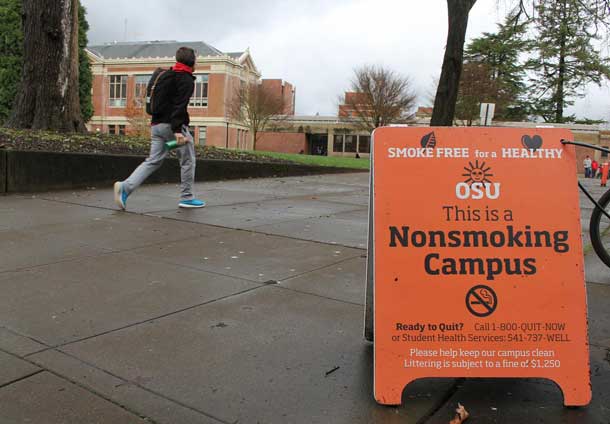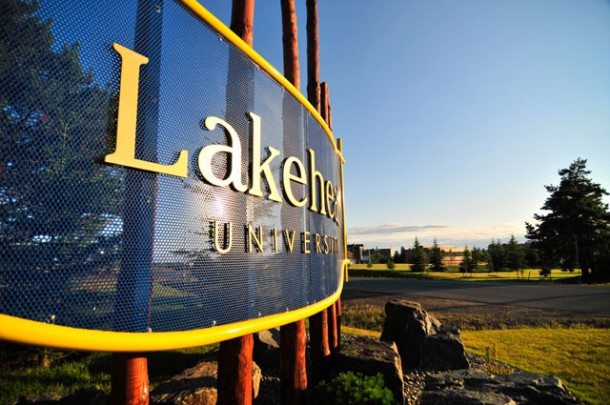
THUNDER BAY – Health – In Thunder Bay the number of places a smoker can light up is increasingly a smaller number. The Thunder Bay Regional Health Sciences Centre went smoke-free in 2014. The program is designed to help people quit smoking.
Now, in Oregon, students, faculty and staff at Oregon State University have largely embraced a new policy that prohibits smoking on the Corvallis campus, but the policy change hasn’t completely eliminated secondhand smoke exposure, new research shows.
 There is no concentrated move to make either Lakehead University or Confederation College a smoke-free zone.
There is no concentrated move to make either Lakehead University or Confederation College a smoke-free zone.
A campus-wide study of the first year of the university’s smoke-free policy showed that 72 percent of students and 77 percent of faculty were in support of the new policy, which took effect in September 2012. That number is expected to rise as people become accustomed to the policy, said Marc Braverman, a professor and Extension specialist in the College of Public Health and Human Sciences at OSU and the study’s lead author.
“The more people live with the change, the more supportive they tend to become,” Braverman said. “We’re not trying to force smokers to quit. We’re trying to address the health concerns brought on by secondhand smoke. This is a clean air policy.”
However, about 77 percent of students and 55 percent of faculty and staff who responded to a survey on the policy reported that they had encountered secondhand smoke near the periphery of the campus within the previous two weeks. In addition, 29 percent of students and 18 percent of faculty and staff said they had been exposed to secondhand smoke near a building entrance on campus in that same time period.
The shift of smoking to campus boundaries is to be expected if people are following the policy, and other universities have experienced the same problem, Braverman said. One of the next steps is figuring out how to reduce the impact of that shift, both in terms of secondhand smoke exposure and other issues, including an increase in cigarette butts and other trash in common smoking locations just off campus.

Findings from the study were published in the February issue of the journal, “Preventive Medicine.” Co-authors are Lisa Hoogesteger, director of OSU’s Healthy Campus Initiatives, and Jessica Johnson, who was a graduate student in public health when the research was conducted. The study was supported by OSU and a grant from PacificSource Health Plans.
Researchers wanted to evaluate the policy implementation because more and more colleges and universities are adopting smoke-free or tobacco-free campus policies, Braverman said. When the idea was initially proposed at OSU in 2008, only 130 campuses nationwide were smoke-free or tobacco-free. As of last month, that number has jumped to 1,500 campuses, according to Americans for Nonsmokers’ Rights, an advocacy group that tracks tobacco policies nationwide.
“It’s gotten to be quite a popular movement, but there is not a lot of information about the best ways to implement a policy like this or what a campus should expect when it does,” Braverman said.
In spring 2013, after almost a full academic year with the policy in place, the researchers invited all students, staff and faculty at OSU’s Corvallis campus to take a web-based survey. More than 5,600 students and 2,000 faculty and staff members responded.
The research team found that there was widespread awareness of the policy change: 89 percent of nonsmoking students and 90 percent of smoking students knew OSU was a nonsmoking campus, while 92 percent of nonsmoking faculty and staff and 99 percent of smoking faculty and staff knew about the policy.
The survey results offer a snapshot of how the policy has been received. Researchers cannot say whether the policy had more or less support at the time of the survey than when it was first enacted because they do not have comparable survey results from that prior point in time.
Survey results showed that nonsmokers were much more likely to favor the policy than smokers. Researchers also found that women were more supportive of the policy than men; international students were more supportive than students from the U.S.; and students who live in a residence hall or belong to a fraternity or sorority were somewhat less likely to support the policy.
While support for the policy was widespread, only 22 percent of students and 29 percent of faculty and staff said they would ask a smoker to put out a cigarette if they saw somebody smoking on campus.
“Enforcement poses some logistical challenges,” Hoogesteger said. “And there are going to be people who challenge the policy.”
Adding signage about the new policy across campus and continuing to educate people about the policy are two ways to help ensure the policy is followed, Hoogesteger said. Secondhand smoke exposure and increased trash in areas near campus boundaries are concerns that need addressing. The university, in conjunction with state and local health officials, also offers resources to help people quit smoking, if they choose to, the researchers said.




